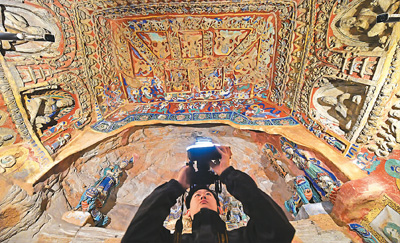Chinese museums, galleries regale netizens with cultural feast through online exhibitions

A staff member of the Yungang Grottoes Research Institute collects data in Yungang Grottoes in Datong, Shanxi Province. (Photo/Xinhua)
Chinese museums and galleries have accelerated their digital transformation and have rolled out online exhibitions through the application of digital technologies while exploring innovative ways to display their exhibits, regaling visitors with a cultural feast both online and offline.
An exhibition featuring about 1,000 ancient female-themed paintings from 32 museums across China was held both offline and online at the Zhejiang Provincial Museum in Hangzhou, capital city of east China’s Zhejiang Province between March 8 and May 8. The museum encouraged Internet users to post photos of themselves wearing traditional Chinese clothes on social media platforms such as Weibo and Xiaohongshu, engaging in active interactions with them online.
“You can tour the digital exhibition hall and find the traditional clothes you like,” a netizen commented.
Chinese museums have also offered online services such as online courses so that visitors can learn more about cultural relics. For example, a guide of the Shanghai Museum took visitors on a virtual tour of the museum’s exhibition of 100 donated cultural relics, through which they could not only enjoy these relics but also learn about the historical and the cultural connotations behind them.
Digital technologies bring cultural relics back to life virtually. With the help of virtual reality (VR) devices, people now can virtually visit the Yungang Grottoes in Datong city, north China’s Shanxi Province, a UNESCO World Cultural Heritage site.
Besides, the Yungang Grottoes Research Institute has cooperated with universities including Zhejiang University in Zhejiang and Wuhan University in central China’s Hubei Province to bring the cultural relics of the grottoes to a wider audience by applying 3D printing technology and VR technology.
Online exhibitions will be able to free cultural relics housed at museums from constraints based on time and space, while providing added convenience for attracting more viewers, according to Wang Yanlong, director of the center for cultural communication studies of Sichuan University in Chengdu, capital of southwest China’s Sichuan Province.
Internet technologies have brought a tremendous change to art exhibitions, bringing high-definition, three-dimensional, and interactive experiences for people, said Yu Kailiang, a professor at the School of Philosophy at Renmin University of China.
China has rolled out measures to encourage more online exhibitions. According to a plan for the development of culture and tourism between 2021 and 2025 released by the Ministry of Culture and Tourism in April 2021, China intends to continually promote the digital transformation of art galleries and online exhibitions.
One month later, nine government authorities that included the Ministry of Science and Technology issued a guideline to advance the reform and development of museums, encouraging online exhibitions and cooperation among museums.
China will boost the development of online digital products for scenic spots and museums and develop new cultural and tourism services such as online exhibitions and immersive experiences, according to a plan issued by China’s State Council in December 2021 to facilitate the development of the digital economy during the 14th Five-Year Plan period (2021-2025).
Photos
Related Stories
- Archaeology museum offers public closer look at history
- Exhibition featuring marine civilization of South China Sea held at Hainan Museum
- Chinese museums overcome geographical boundaries after holding online exhibitions
- People visit exhibitions at Times Art Museum in Beijing
- Sneak peek of conceptual design of New Sanxingdui Museum
- Mimara Museum illuminated during Festival of Lights in Zagreb, Croatia
- Chengdu Museum showcases costumes featuring Silk Road culture
- Nanjing city wall museum opens for trial service
- Shenyang Museum opens for visitors
- People visit industrial museum in Chongqing
Copyright © 2022 People's Daily Online. All Rights Reserved.










